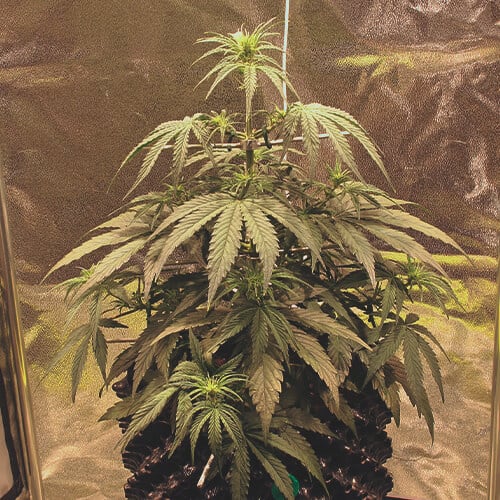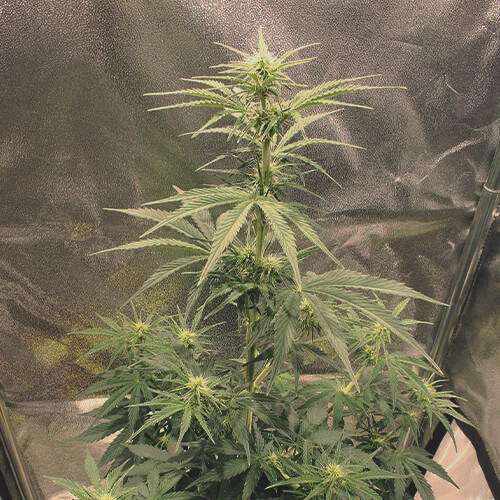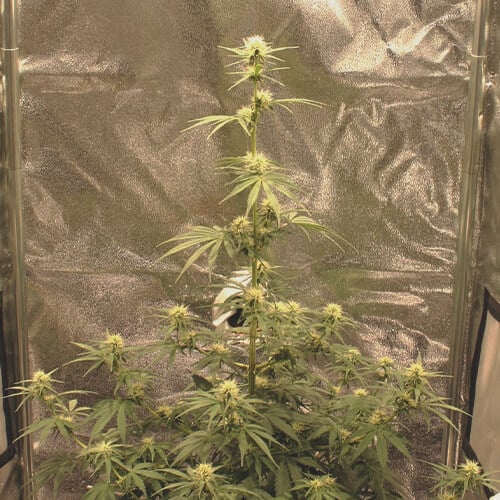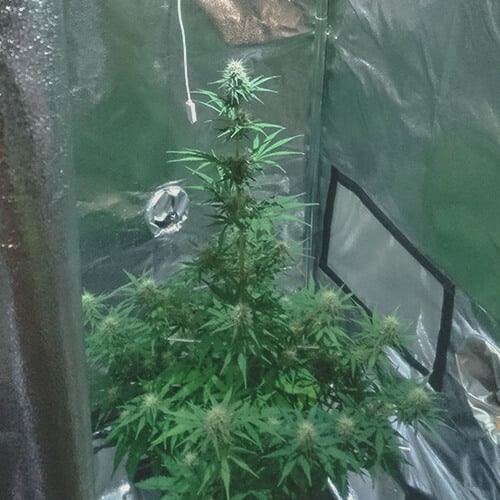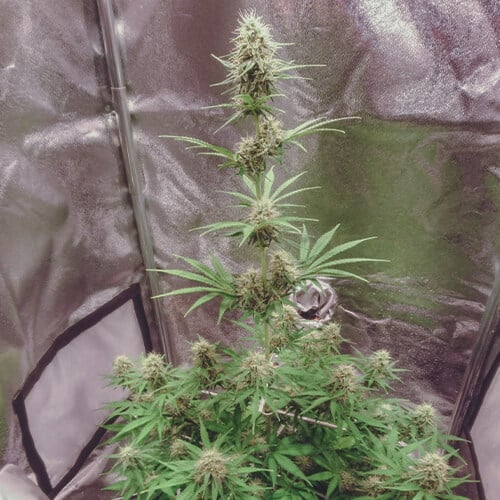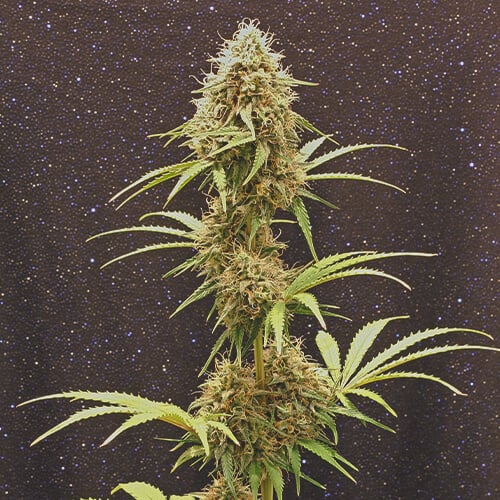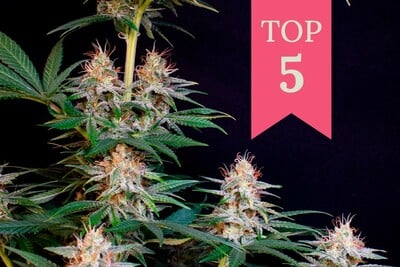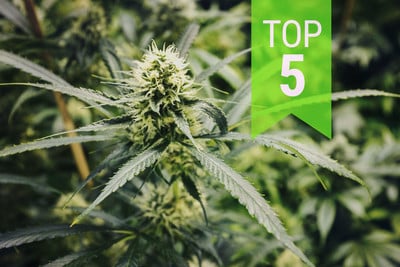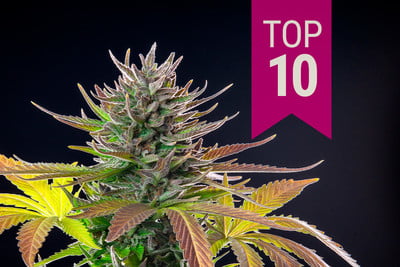.

Amnesia Haze Automatic Grow Report
Amnesia Haze Automatic offers both beginner and veteran growers an easy and rapid harvest of fruity flowers. Check out how we grew her, and what strategies we used in each stage.
Contents:
Amnesia Haze belongs to the world-famous Amnesia lineage. This variety carries the family name with pride, offering massive THC levels and a stimulating high characteristic of Dutch genetics. Check out our grow report to learn exactly how to cultivate this legendary variety. Then, discover the genetic history, effects, and morphology of this durable and exciting strain.
Equipment List
- 60x60cm growing space
- 220/360m³ extraction fan (running at 220)
- 20W oscillating fan
- Air pot
- 2 100W LEDs
- Nutrient-loaded soil
- Reverse osmosis water ~100ppm
Amnesia Haze Automatic Grow Report: Seedling Stage
After our breeders perfected Amnesia Haze Automatic, we decided to put our skills to the test and dedicate some time to cultivating the strain. We documented the entire process so you can achieve the same results for yourself!
- Germination: As with all grows, the journey began with a small and humble seed. We dropped it into a glass of tap water and left it to soak for 36 hours until the taproot emerged from the shell.
- Growing medium: We selected a mix of nutrient-loaded soil and a layer of nitrogen-rich worm humus to line the bottom of the pot.
- Potting up: We placed the seed into a shallow hole (taproot facing down) in its final container, a 9L airpot designed to assist plants in developing healthy and fibrous roots.
- Lighting: We rigged up two 100W LED lights to see our plant through the entire growing cycle. We selected an 18/6 cycle to ensure optimal photosynthesis while bringing down the overall cost of the growing operation.
- Cotyledon leaves: The first two cotyledon leaves quickly emerged from the soil within days of potting up. The first two true leaves appeared four days later, marking the start of the vegetative phase.
- Nutrients: Throughout the seedling stage, we applied the following nutrients formula per litre of reverse osmosis water:
- 1.5ml/l Seaweed extract
- 1.3ml/l Compost Tea
- 0.65ml/l mycorrhizal fungi

Amnesia Haze Auto
|
|
Amnesia x Ruderalis |
|
|
350 - 400 gr/m2 |
|
|
50 - 100 cm |
|
|
7 - 8 weeks |
|
|
THC: 18% |
|
|
Sativa 50% Indica 20% Ruderalis 30% |
|
|
130 - 180 gr/plant |
|
|
100 - 120 cm |
|
|
11 - 12 weeks after sprouting |
|
|
Clear, Uplifting |
Amnesia Haze Automatic Grow Report: Vegetative Stage
As a fast-growing cultivar, Amnesia Haze Auto blasted through the vegetative phase—a period defined by the productivity of fan leaves and a general increase in size. Overall, the vegetative phase lasted only four weeks. Here are the steps we took during this time:
- Lighting: We kept the 100W LEDs on an 18/6 cycle. We suspended the light source 110cm above the canopy to give the plant room to expand throughout the vegetative phase. Towards the end of this stage, the canopy sat around 70cm from the light source.
- Watering: To keep things simple, and to avoid over/underwatering, we only watered after the top inch of soil became dry. This ended up averaging out to around 0.5l of reverse osmosis water every 24 hours.
- Environment: Using a thermo-hygrometer to measure environmental factors, we managed to keep the average temperature at 20°C, with relative humidity at 45-50%. We maintained this sweet spot using a fan, exhaust, and a humidity sensor rigged up in the grow tent.
- Nutrients: We tailored our nutrient formulas week by week to provide the plant with varying levels of minerals depending on the stage of growth. During the veg phase nitrogen is the most important NPK value, so our nutrients ratio targeted this with a 2:1:2 and 4:2:3 fertiliser. In addition, we complemented our feeding with the following throughout the rest of the vegetative phase:
Week Three and Four
- 0.5ml/l calcium/magnesium
- 1ml/l seaweed extract
- 0.6ml/l sugar beet extract
- 1.3ml/l mycorrizhal fungi
- 1.3ml/l compost tea
Potential issues: During the fourth week of the grow, our plant began to exhibit signs of fertiliser burn on the leaves. We put this down to an excess amount of worm humus placed in with the main growing medium. Next time, we plan on avoiding this amendment to prevent the same symptoms arising.
Pre-flower: Our Amnesia Haze Automatic specimen began shifting into the flowering phase in the fourth week of the vegetative stage. Small calyxes with protruding pistils began emerging at the nodes, marking the start of blooming.
 |
 |
 |
| (Seedling stage) | (Week 3) | (Week 4) |
Amnesia Haze Automatic Grow Report: Flowering Stage
Our plant spent most of her life cycle in the flowering phase, which gave her adequate time to develop large and resinous flowers. It only took six weeks for her pre-flowers to grow into fully ripe, large, and resinous colas.
- Lighting: As an autoflowering variety, Amnesia Haze Auto doesn’t require a change in the light cycle to trigger flowering. We kept our LEDs running on an 18/6 cycle, suspended now 45cm above the tip of the canopy.
- Watering: As the plant grew larger and the colas matured, her demand for water increased. After waiting for the top layer of soil to dry, we gave her an average of 1.5l of reverse osmosis water per day.
- Environment: We reduced the humidity to 40% by adjusting the settings on the sensor. This helped reduce the risk of mould formation as the flowers started to become more dense and prone to infection. We raised the temperature to 25°C using a heater to promote an optimal flowering environment.
- Defoliation: We armed ourselves with trimming scissors and chopped off older and yellowing fan leaves throughout the flowering phase. This decision allowed us to increase the amount of light penetrating the canopy and improve the airflow, which would help to deter mould formation. During the first week, we defoliated all of the fan leaves from the main stem to achieve these advantages.
- LST: We conducted low-stress training during week seven to promote increased lateral growth. This training technique allowed the plant to develop a wider canopy with more bud sites, as opposed to a more vertical plant with more energy directed towards the central cola.
Noteworthy Occurrences:
Visible Mycelium
During the flowering stage, we started to notice filamentous fungi begin to overtake the surface of the soil. Fearing a root-rotting pathogen, we were pleased to realise that these were in fact hyphae from the mycorrhizal mycelium we had introduced to the soil. These organisms work in symbiosis with plant roots and help them to access nutrients.
An Unusual Mutation
During week seven, a calyx that emerged to the side of a node right next to the main stem. By week ten, it became a fully formed yet compact flower. We hope to see some skilled growers isolate and develop this odd yet fascinating trait!
- Nutrients: We modified the original nutrients blend to cater for increased demand for potassium and phosphorus during the flowering phase. Check out the lists below for the strategies we utilised week by week during bloom:
Week Five
During the first week of flowering, we switched up the nutrients slightly to gently transition the plant into a flowering feeding cycle. We started with an NPK 5:7:10 fertiliser, and then we finished with an NPK ratio of 4:7:10.
- 0.5ml/l calcium/magnesium
- 0.3ml/l seaweed extract
- 0.3ml/l humic and fulvic acid
- 1.3ml/l mycorrizhal fungi
- 1.3ml/l compost tea
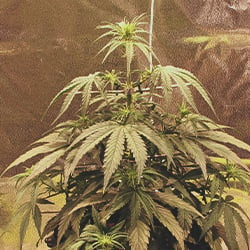 |
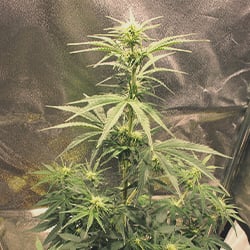 |
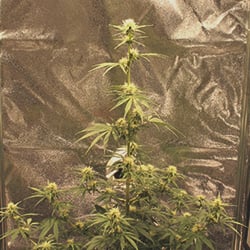 |
| (Week 5) | (Week 6) | (Week 7) |
Week Six
Here, we started to ramp up the necessary minerals required for healthy flower development. We boosted calcium and magnesium levels by 1ml/l. Additional microbes were added to help the root system access these extra nutrients.
Week Seven
The feeding schedule remained largely identical to week six, with the addition of more seaweed extract and the removal of mycorrhizal fungi amendments.
Week Eight
After seeing the early signs of nutritional deficiencies in some fan leaves, we slightly increase the levels of sugar beet extract in an attempt to rectify the situation.
Week Nine
We continued observing more yellowing so decided to boost the sugar beet and fulvic and humic acid extracts by around 50%. iThis strategy quickly solved the deficiencies, and the plant started to appear healthy almost right away!
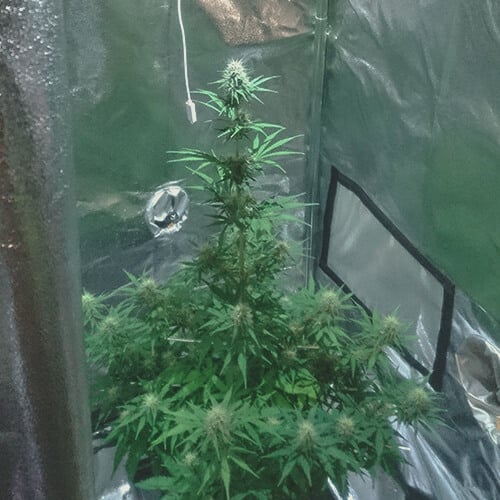 |
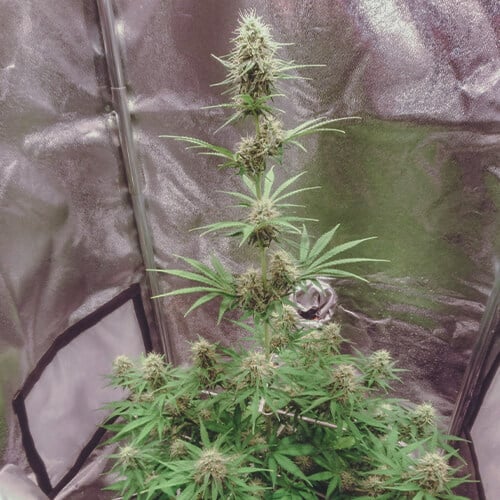 |
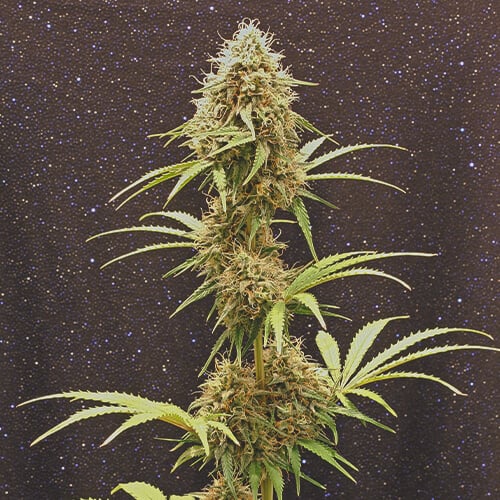 |
| (Week 8) | (Week 9) | (Week 10) |
Week Ten
The final week of feeding before the flush. By this point, the flowers were looking plump, resinous, and loaded with trichomes. We added even more seaweed extract to give the buds one last boost while holding back on more calcium and magnesium.
- Flushing: We flushed our plant thoroughly one week before harvest to remove excess nutrients from the growing medium. Using reverse osmosis water, we completely flooded the soil every time it dried out. We waited for it to drain and immediately flooded it twice more. This made for smoother and better-tasting buds.
- Harvest: We harvested the mature flowers when around half of the pistils became dark orange, and most of the trichomes displayed an opaque milky colour. We hung the entire plant to dry, dry-trimmed the buds, and cured them for several weeks.
Genetic Attributes of Amnesia Haze Automatic
Royal Queen Seeds breeders gave life to Amnesia Haze Automatic after crossing the legendary Amnesia with an autoflowering variety. After fine-tuning this mix over several generations, they quickly secured a stable and consistent phenotype consisting of 50% sativa genetics, 20% indica, and 30% ruderalis. The fusion of ruderalis and Amnesia made the strain easier to grow, faster to flower, and much more accessible to beginners.
Growing Characteristics of Amnesia Haze Automatic
Amnesia Haze Auto never exceeds a medium height, which makes her ideal for cultivators dealing with limited space, or those intentionally seeking a stealthy strain. Indoor plants grow to a height of 50–100cm and produce between 350–400g/m².
Plants grown outdoors in containers or garden beds grow to a slightly taller height of 100–120cm and produce anywhere between 130–180g/plant depending on space and sunlight exposure. Amnesia Haze Automatic explodes from a tiny seed into a canopy full of buds in as little as ten weeks. She offers a rapid turnover ideal for covert and larger-scale growers alike.
Effects and Flavour of Amnesia Haze Automatic
Amnesia Haze Auto packs a significant amount of THC for an autoflowering variety. A quantity of 18% ignites a well-rounded high that primarily energises the mind. After several hits, you’ll experience a light stimulation that inspires creative thoughts and a desire to get the day’s goals complete. A soft and soothing body high underpins this feeling of motivation, grounding the head high and preventing it from becoming too excitable. Every hit of smoke or vapour lights up the tongue with moreish hints of earthiness and citrus, courtesy of the terpenes terpinolene, caryophyllene, and myrcene.






























